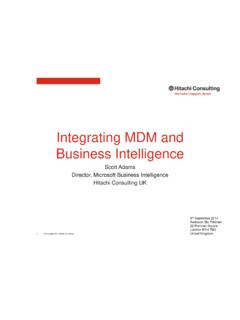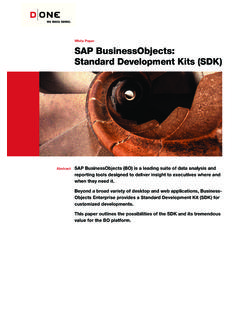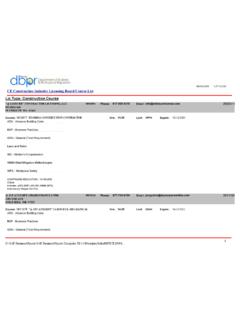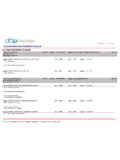Transcription of SPONSORED BY Critical Success Factors - 1105 Media
1 TDWIMONOGRAPH SERIESJUNE 2005 The Keys to Enterprise Business Intelligence: Critical Success FactorsBy Wayne W. EckersonDirector of Research The Data Warehousing InstituteSPONSORED BY _____ 2 About the Author WAYNE W. ECKERSON is the director of research for The Data Warehousing Institute (TDWI), a worldwide association of business intelligence and data warehousing professionals that provides education, training, certification, and research. Eckerson has 17 years of experience in the IT industry, most of which has been spent covering data warehousing and business intelligence. Eckerson is the author of many in-depth reports, a columnist for several business and technology magazines, and a noted speaker and consultant in the business intelligence industry. He has recently written a book titled Performance Dashboards: Measuring, Monitoring, and Managing Your Business, which will be published by John Wiley & Sons in October 2005.
2 He can be reached at Besides his research duties, Eckerson coordinates TDWI s BI Strategies program, a quarterly educational event that brings together thought leaders and practitioners in the business intelligence field to discuss and share ideas about emerging trends and technologies. Prior to joining TDWI, Eckerson was a senior consultant at the Patricia Seybold Group and director of its Business Intelligence & Data Warehouse Service, which he launched in 1996. About Our Sponsor BUSINESS OBJECTS is the world s leading business intelligence (BI) software company. With more than 30,000 customers worldwide, including over 80 percent of the Fortune 500, Business Objects helps organizations gain better insight into their business, improve decision making, and optimize enterprise performance. The company s business intelligence platform, BusinessObjects XI, offers the BI industry s most advanced and complete platform for reporting, query and analysis, performance management, and data integration.
3 BusinessObjects XI includes Crystal Reports , the industry standard for enterprise reporting. Business Objects has also built the industry s strongest and most diverse partner community, and offers consulting and education services to help customers effectively deploy their business intelligence projects. Business Objects has dual headquarters in San Jose, CA, and Paris, France. The company s stock is traded on both the Nasdaq (BOBJ) and Euronext Paris (ISIN: FR0004026250 BOB) stock exchanges. More information about Business Objects can be found at _____ 3 Promise and Reality The Promise of Self-Service BI. When end-user reporting and analysis tools made their debut in the early 1990s on Windows desktops, many experts believed the tools would liberate end users from their dependency on the IT department to create and deliver custom reports. The combination of these tools and newly minted data warehouses caused pundits to proclaim that the era of self-service business intelligence (BI) had arrived.
4 However, reality quickly fell short of promise. It turned out that a majority of users found early versions of BI tools too difficult to use, and continued to rely on the IT department to create custom reports. And many of the remaining power users used BI tools simply to download huge data sets to their desktops clogging networks and bogging down query performance for everyone else. They then dumped the data into Microsoft Excel or Access, where they conducted their real analysis, creating dozens, if not hundreds, of spreadmarts and undermining data consistency. The advent of the Web as a BI delivery vehicle has made it easier for organizations to deploy business intelligence on an enterprise scale. The Web centralizes administration, removes the need to install software on users desktops, and provides an intuitive user interface that reduces user training and support costs. However, simply migrating BI to the Web is not enough to deliver enterprise business intelligence so that all employees can easily access, analyze, and act on relevant and timely information.
5 BI Platforms. To transform business intelligence from a workgroup or departmental initiative geared to business analysts into an enterprise resource that empowers all users, organizations need more than just BI tools. They need a BI platform that supports a variety of reporting and analysis processes and applications and runs against a robust data management infrastructure that delivers a consistent view of the business. This combination delivers the right information to the right person at the right time, creating a nimble, fast-moving organization that is much more responsive to market changes and customer requirements. A BI platform offers many advantages. It provides of a core set of functionality and modules designed to meet the unique information and analytical requirements of a broad range of users within the enterprise. It lets developers rapidly customize and extend the BI platform s core BI components and services to create new analytic applications or embed BI functionality within existing applications.
6 It also supports metadata linkages to data integration tools and other upstream and downstream systems to create an integrated BI environment that is easy to adapt to evolving business requirements. Finally, both the BI and data platforms are built on a scalable and extensible infrastructure that meets data center requirements for reliability, availability, and performance. Given these new capabilities, organizations should take the opportunity to reevaluate their business needs, user requirements, and technical architecture before purchasing new BI tools or extending existing BI licenses. BI platforms can help transform the Migrating BI to the Web is not Enough to Deliver True Enterprise BI BI Platforms Are The Next-Generation BI Tools _____ 4 way organizations leverage and exploit information, but this won t happen unless executives and managers take a step back and approach BI strategically.
7 They need to create a road map that consolidates pockets of BI tools, performance management, and reporting repositories throughout the organization, and create a mission- Critical , enterprise BI platform that supports the reporting and analytical needs of all workers in the organization. Critical Success Factors Leading vendors are now beginning to deliver BI platforms that are finally realizing the promise of self-service business intelligence for all users. This new generation of BI software exhibits six main characteristics. While few vendors today deliver all the capabilities described below, these characteristics provide a way to gauge vendors progress toward meeting the enterprise BI requirements. The rest of this paper will discuss each of these characteristics. Characteristic #1: Support All Users Via Integrated BI Suites One Vendor Versus One Tool. Executives have always sought to purchase a single BI tool for the enterprise to reduce administration, training, and support costs and minimize the number of suppliers and redundant software.
8 They quickly discovered, however, that one tool can t possibly meet the needs of different types of users, and begrudgingly allowed departments and teams to purchase different tools, sometimes from different vendors. Fortunately, leading BI vendors are heeding the calls of executives. However, rather than delivering a single BI tool, leading vendors are delivering BI platforms that support suites of integrated BI tools or modules. These suites integrate a wide range of functionality that meets the reporting and analytical requirements of many different types of BI users. They also enable executives to negotiate volume discounts with a single supplier while delivering specialized functionality to distinct segments of users. User Characteristics Drive Segmentation. To leverage these suites, organizations need to identify all of the different types of BI users in the organization. To fully leverage the functionality offered by BI platforms, organizations need to identify the different types of BI users.
9 Most companies create between four and eight different segments of BI users based on one or more of the following characteristics: 1. Business role. Typical roles include executive, manager, power user, business analyst, customer, and supplier, but the roles may be more granular. 2. Analytical need. Users can be segmented by whether they need to author, customize, interact with, or view reports, query source data, create forecasts, develop planning scenarios, or develop statistical models. BI Suites Enable Executives to Deal with One Vendor While Meeting All Users Needs _____ 5 3. Access and delivery preferences. Different users may prefer to access or receive information via different methods, such as Windows, the Web, e-mail, wireless devices, or printers. 4. Technical and analytical literacy. Individuals vary by the degree to which they are comfortable working with computers and know how to analyze and interpret data. This is a gating factor on BI usage.
10 Once an organization identifies distinct user segments, it then needs to map BI functionality to each segment. (See Exhibit 1.) Using a BI platform, administrators can then turn BI functionality on or off to meet individual or group requirements using dynamic, role-based security. For example, a BI platform may allow a small group of users to author reports, a larger group to modify those reports and export to Excel, and the largest group to receive static views of the reports by e-mail. Exhibit 1 Mapping BI User Segments to BI Functionality. This chart maps different types of BI users to BI functionality, arranged according to breadth of delivery (reporting) and depth of insight (analysis). This summarized view depicts four types of BI consumers and four types of BI authors. Some organizations may have more user and author segments and finer-grained descriptions of BI functionality. Common Framework. The BI platform enables organizations to purchase additional modules to support more than just bread-and-butter reporting and analysis functions.











